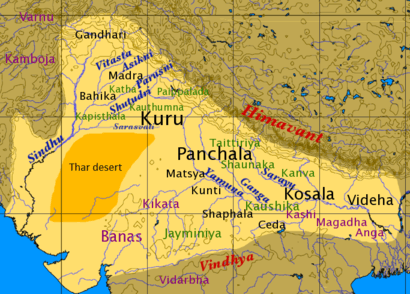Kambu Swayambhuva

Kambu Swayambhuva was one of the many sages in Hinduism mentioned along with Agastya, Kaundinya, Rajendra Chola I, Ashoka and Pushyamitra Shunga in shloka 22 of the Ekamata Stotra.
History
Legend says that Kambu Swayambhuva was a learned prince who had initially been an Indian king. He had ventured into the far East and entered an area having jungles that was being ruled by a king of the Naga people. Defeating their king, Kambu married the princess, Mera, and developed the land into a fertile and flourishing country. The combination of Kambu and Mera names is said to have given rise to the name Khmer (Kambu + Mera =Khmer) according to George Coedes.[1]
Kambu Swayambhuva is claimed to be the eponym of the Kambojas of who he is the ancestor with his wife Mera, who was given to him by Shiva.[2] Princes of Kambodia expressly state themselves as Kambujas and to have descended from the lineage of Kambu.
The name Kambu is stated to be a corruption of the standard Sanskrit Kamboja.[3] Scholars such as C. Lassen, S. Levi, M. Witzel, J. Charpentier, A. Hoffman, A. B. Keith, A. A. Macdonell, H. W. Bailey and many others have traced the ethnic name Kamboja in the royal name Kambujiya in the Old Persian Inscriptions (Cambyses/Kambuses of the Greeks.[4] Parskar Gryhamsutram spells the usual Kamboja as Kambuja.[5] The Markandeya Purana (8.1-6) as well as in Srimad Devi Bhagawatam (5.28.1-12) etc. refers to the Kambojas as Kambu clan. King Ashoka's Rock Edicts V & XIII located at Peshawar write Kamboj as Kamboy or Kambo. According to J. W. McCrindle, Kamboja (=Afghanistan) is Kaofu (Kambu) of Xuanzang[6] The Tathāgatagarbha Sūtra of Buddhism uses the word Kieufieu (i.e. Kaofu of Xuanzang) for the Kamboja. The reference Kieufieu of the Tathāgatagarbha Sūtra stands translated variously as Kampoce, Kampochih and Kampotse etc. in the Tibetan religious texts.
Numerous Muslim writings of mediaeval era spell the Kamboj clan name as Kambu as well as Kambo. Obviously, these Kambu/Kambo terms are the corrupted forms of Kambuj/Kamboj and relate to the Kamboja of ancient Sanskrit and Pali texts and Inscriptions. This Sanskrit Kamboja appears as K.b.u.ji.i.y, Kabujiya or perhaps Kabaujiya/Kaboujiya and Kambujiya or perhaps Kambaujiya ( OR with -n- in place of -m- as Kanbujiya or Kanbaujiya) of Old Persian inscriptions, and Cambyses of Greek writings. The same name appears as C-n-b-n-z-y in Aramaic, Kambuzia in Assyrian, Kambythet in Egyptian, Kam-bu-zi-ya or Ka-am-bu-zi-ya in Akkadian, Kan-bu-zi-ia or Kan-bu-si-ya in Elamite, and Kanpuziya in the Susan language (cf: Ancient Kamboja in Iran and Islam, p 69, Dr H. W. Bailey).
See also
References
- ↑ D'après l'épigraphie cambodgienne du X° siècle, les rois des "Kambuja" prétendaient descendre d'un ancêtre mythique éponyme, le sage ermite Kambu, et de la nymphe céleste Mera, dont le nom a pu être forgé d'après l'appellation ethnique "khmèr" (George Coedes). ; See also: Indianised States of Southeast Asia, 1968, p 66, George Coedes.
- ↑ Indianised States of Southeast Asia, 1968, p 66, 47, George Coedes
- ↑ Ancient Kamboja, People and the Country, 1981, pp 359-60, Dr J. L. Kamboj.
- ↑ Early East Iran and Atharvaveda, Persica, 1980, pp 114-15, ffn 81, Dr Michael Witzel).
- ↑ Parskar Gryhamsutram 2.1.23
- ↑ Alexander's Invasion, p 38; See also Some Kshatriya Tribes of Ancient India, p 235, Dr B. C. Law